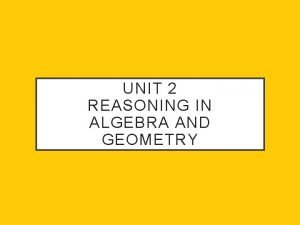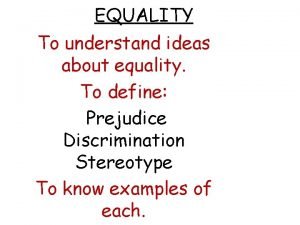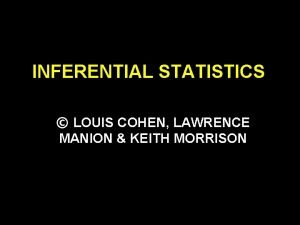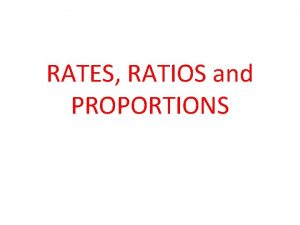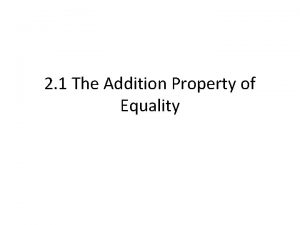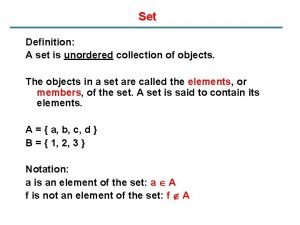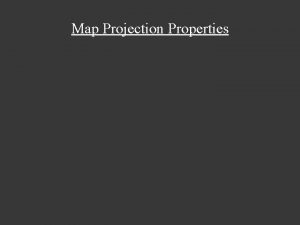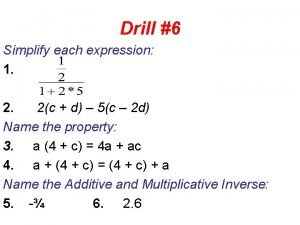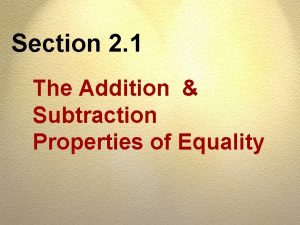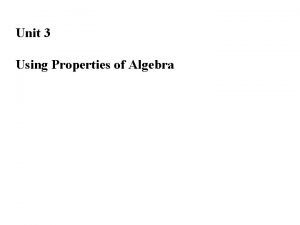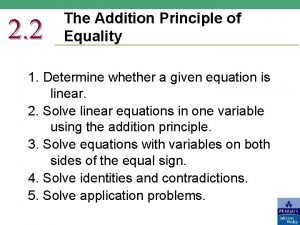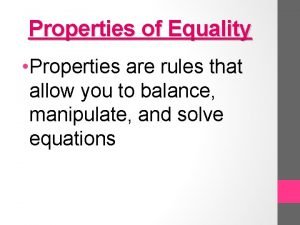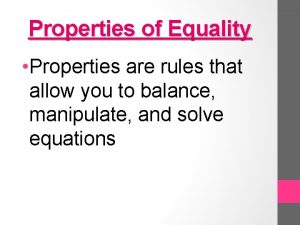Properties of Equality Properties of Equality Properties are











































- Slides: 43

Properties of Equality

Properties of Equality Properties are rules that allow you to balance, manipulate, and solve equations

Addition Property of Equality Adding the same number to both sides of an equation does not change the equality of the equation. If a = b, then a + c = b + c. Ex: x = y, so x + 2 = y + 2

Subtraction Property of Equality Subtracting the same number to both sides of an equation does not change the equality of the equation. If a = b, then a – c = b – c. Ex: x = y, so x – 4 = y – 4

Multiplication Property of Equality Multiplying both sides of the equation by the same number, other than 0, does not change the equality of the equation. If a = b, then ac = bc. Ex: x = y, so 3 x = 3 y

Division Property of Equality

Reflexive Property of Equality A number is equal to itself. (Think mirror) a = a Ex: 4 = 4

Symmetric Property of Equality If numbers are equal, they will still be equal if the order is changed (reversed). If a = b, then b = a. Ex: x = 4, then 4 = x

Transitive Property of Equality If numbers are equal to the same number, then they are equal to each other. If a = b and b = c, then a = c. Ex: If x = 8 and y = 8, then x = y

Commutative Property Changing the order of addition or multiplication does not matter o Addition: a+b=b+a Multiplication: a∙b=b∙a

Associative Property The change in grouping of three or more terms/factors does not change their sum or product. o Addition: a + (b + c) = (a + b) + c Multiplication: a ∙ (b ∙ c) = (a ∙ b) ∙ c

Additive Identity Property The sum of any number and zero is always the original number a + 0 = a Ex: 4 + 0 = 4

Multiplicative Identity Property The product of any number and one is always the original number. Multiplying by one does not change the original number. a ∙ 1 = a Ex: 2 ∙ 1 = 2

Additive Inverse Property The sum of a number and its inverse (or opposite) is equal to zero. a + (-a) = 0 Ex: 2 + (-2) = 0

Multiplicative Inverse Property The product of any number and its reciprocal is equal to 1.

Multiplicative Property of Zero The product of any number and zero is always zero. a ∙ 0 = 0 Ex: 298 ∙ 0 = 0

Solve Systems of Equations by Graphing

Solve Systems of Equations by Graphing 1. 2. 3. 4. Make sure each equation is in slopeintercept form: y = mx + b. Graph each equation on the same graph paper. The point where the lines intersect is the solution. If they don’t intersect then there’s no solution. Check your solution algebraically.

1. Graph to find the solution.

2. Graph to find the solution. 2. Graph to find the solution.

3. Graph to find the solution.

Types of Solutions

So basically…. If the lines have the same y-intercept b, and the same slope m, then the system is consistent-dependent. If the lines have the same slope m, but different yintercepts b, the system is inconsistent. If the lines have different slopes m, the system is consistent-independent.

Solve Systems of Equations by Elimination

Steps for Elimination: 1. 2. 3. 4. 5. Arrange the equations with like terms in columns Multiply, if necessary, to create opposite coefficients for one variable. Add the equations. Substitute the value to solve for the other variable. Check

EXAMPLE 1 (continued)

EXAMPLE 2 4 x + 3 y = 16 2 x – 3 y = 8

Solve Systems of Equations by Substitution

Steps 1. 2. 3. 4. 5. One equation will have either x or y by itself, or can be solved for x or y easily. Substitute the expression from Step 1 into the other equation and solve for the other variable. Substitute the value from Step 2 into the equation from Step 1 and solve. Your solution is the ordered pair formed by x & y. Check the solution in each of the original equations.

Solve by Substitution 1. x = -4 3 x + 2 y = 20

Solve by Substitution 2. y = x - 1 x+y=3

Graphing Inequalities

Steps Get in slope-intercept form Determine solid or dashed line Determine whether to shade above or shade below the line (Test Points) If the test point is true, shade the half plane containing it. If the test point is false, shade the half plane that does NOT contain the point

Symbols Shade above > ≥

Symbols Shade Below < ≤

Symbols Solid Line ≤ ≥

Symbols Dashed Line < >

Example 1

Example 2

Example 3

Example 3 Solution

Example 4

Example 4 Solution
 Mikael ferm
Mikael ferm Formal equality vs substantive equality
Formal equality vs substantive equality Formal equality vs substantive equality
Formal equality vs substantive equality Property of congruence
Property of congruence Identity property geometry
Identity property geometry Subtraction property of equality
Subtraction property of equality Identity property of equality
Identity property of equality Properties of equality worksheet
Properties of equality worksheet Extensive examples
Extensive examples Physical property and chemical property
Physical property and chemical property Care certificate standard 4
Care certificate standard 4 Equity vs equality
Equity vs equality Addition property of equality
Addition property of equality Ideology of individualism
Ideology of individualism Women equality
Women equality Tax equality
Tax equality Health and social care unit 2
Health and social care unit 2 Equality comparatives ejemplos
Equality comparatives ejemplos Equality act lift
Equality act lift What is equality
What is equality Eta squared statistics
Eta squared statistics Conclusion of equality
Conclusion of equality Mona talent priority
Mona talent priority A statement of equality between two ratios
A statement of equality between two ratios Addition property of equality definition
Addition property of equality definition Sets are equal
Sets are equal Comparisons of equality
Comparisons of equality Liberty equality fraternity
Liberty equality fraternity Property of equality for exponential functions
Property of equality for exponential functions Equality equity justice fence
Equality equity justice fence Equality wheel
Equality wheel French revolution
French revolution The relative size of different elements of an artwork
The relative size of different elements of an artwork Liberty equality fraternity
Liberty equality fraternity Equality vs equity
Equality vs equity Comparison of equality practice
Comparison of equality practice What is gender equality answer
What is gender equality answer Organization of cartographers for social equality
Organization of cartographers for social equality How to simplify each expression
How to simplify each expression Equality equity
Equality equity Rstuv method
Rstuv method Jarzynski equality
Jarzynski equality Substitution property
Substitution property The addition principle
The addition principle



